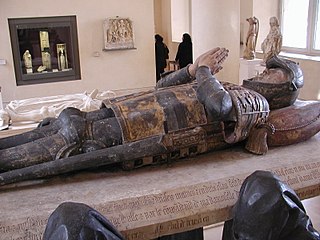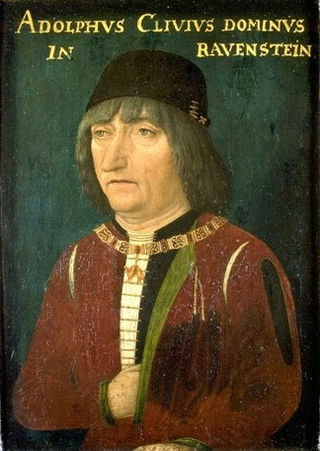
Year 1477 (MCDLXXVII) was a common year starting on Wednesday of the Julian calendar.

Philip II the Bold was Duke of Burgundy and jure uxoris Count of Flanders, Artois and Burgundy. He was the fourth and youngest son of King John II of France and Bonne of Luxembourg.

Louis XI, called "Louis the Prudent", was King of France from 1461 to 1483. He succeeded his father, Charles VII. Louis entered into open rebellion against his father in a short-lived revolt known as the Praguerie in 1440. The king forgave his rebellious vassals, including Louis, to whom he entrusted the management of the Dauphiné, then a province in southeastern France. Louis's ceaseless intrigues, however, led his father to banish him from court. From the Dauphiné, Louis led his own political establishment and married Charlotte of Savoy, daughter of Louis, Duke of Savoy, against the will of his father. Charles VII sent an army to compel his son to his will, but Louis fled to Burgundy, where he was hosted by Philip the Good, the Duke of Burgundy, Charles' greatest enemy.

Charles I, nicknamed the Bold, was Duke of Burgundy from 1467 to 1477.

Mary of Burgundy, nicknamed the Rich, was a member of the House of Valois-Burgundy who ruled a collection of states that included the duchies of Limburg, Brabant, Luxembourg, the counties of Namur, Holland, Hainaut and other territories, from 1477 until her death in 1482.

Philip III was Duke of Burgundy from 1419 until his death. He was a member of a cadet line of the Valois dynasty, to which all 15th-century kings of France belonged. During his reign, the Burgundian State reached the apex of its prosperity and prestige, and became a leading centre of the arts.

In the history of the Low Countries, the Burgundian Netherlands or the Burgundian Age is the period between 1384 and 1482, during which a growing part of the Low Countries was ruled by the Dukes of Burgundy. Within their Burgundian State, which itself belonged partly to the Holy Roman Empire and partly to the Kingdom of France, the dukes united these lowlands into a political union that went beyond a personal union as it gained central institutions for the first time.

Louis de Bruges, Lord of Gruuthuse, Prince of Steenhuijs, Earl of Winchester, was a Flemish courtier, bibliophile, soldier and nobleman. He was awarded the title of Earl of Winchester by King Edward IV of England in 1472, and was Stadtholder of Holland and Zeeland 1462–77.

The House of Valois-Burgundy, or the Younger House of Burgundy, was a noble French family deriving from the royal House of Valois. It is distinct from the Capetian House of Burgundy, descendants of King Robert II of France, though both houses stem from the Capetian dynasty. They ruled the Duchy of Burgundy from 1363 to 1482 and later came to rule vast lands including Artois, Flanders, Luxembourg, Hainault, the county palatine of Burgundy (Franche-Comté), and other lands through marriage, forming what is now known as the Burgundian State.

Philippe Pot (1428–1493) was a Burgundian nobleman, military leader, and diplomat. He was the seigneur of La Roche and Thorey-sur-Ouche, a Knight of the Golden Fleece, and the Grand Seneschal of Burgundy.

The Burgundian inheritance in the Low Countries consisted of numerous fiefs held by the Dukes of Burgundy in modern-day Belgium, Netherlands, Luxembourg, and in parts of France and Germany. The Duke of Burgundy was originally a member of the House of Valois-Burgundy and later of the House of Habsburg. Given that the Dukes of Burgundy lost Burgundy proper to the Kingdom of France in 1477, and were never able to recover it, while retaining Charolais and the Free County of Burgundy, they moved their court to the Low Countries. The Burgundian Low Countries were ultimately expanded to include Seventeen Provinces under Charles V, Holy Roman Emperor. The Burgundian inheritance then passed to the Spanish branch of the Habsburgs under Philip II of Spain, whose rule was contested by the Dutch revolt, and fragmented into the Spanish Netherlands and the Dutch republic. Following the War of the Spanish succession, the Habsburg Netherlands passed to Austria and remained in Austrian hands until the French conquest of the late 18th century. The Bourbon Restoration did not re-establish the Burgundian states, with the former Burgundian territories remaining divided between France, the Netherlands and, following the Belgian Revolution, modern-day Belgium.

Adolph of Cleves, Lord of Ravenstein (1425–1492) was the youngest son of Adolph I, Duke of Cleves, and of his wife Marie of Burgundy, a sister of Philip the Good, Duke of Burgundy.

Adolf of Egmond was a Duke of Guelders, Count of Zutphen from 1465–1471 and in 1477.
Philibert Hugonet was a French Roman Catholic bishop and cardinal.

In the period 1482–1492, the cities of the County of Flanders revolted twice against Maximilian of Austria, who ruled the county as regent for his son, Philip the Handsome. Both revolts were ultimately unsuccessful.

Guy de Brimeu known as the great or Gwijde of Brimeu, was a knight of the Golden Fleece, he was beheaded in Ghent on 3 April 1477.

Pieter Bladelin was an important financial advisor and civil servant to the Burgundian State. He was lord of Middelburg and built the Hof Bladelin in Bruges.

Middelburg is a village and a district in the municipality of Maldegem, in East Flanders, Belgium. Founded as a town by Pieter Bladelin in the 15th century, it still contains the medieval church with the tomb of Bladelin and his wife.

The Burgundian State is a concept coined by historians to describe the vast complex of territories that is also referred to as Valois Burgundy.

The Revolt of Ghent (1379-1385) was an uprising by the city of Ghent against the count of Flanders and the king of France. Under the leadership of successively Jan Hyoens, Philip van Artevelde and Frans Ackerman, Ghent rebelled against Count Louis II of Flanders, Duke Philip the Bold of Burgundy and King Charles VI of France. It was an expression of the growing power of the Third Estate and of economic ties with England that had been strained by the Hundred Years' War. After six years of war, Ghent submitted to the ducal authority while avoiding further punishment. The dream of an autonomous city-state failed, and the era of royal centralization continued.



















